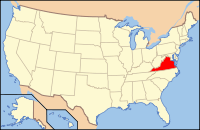Oatlands Plantation
|
Oatlands Historic District | |
.jpg) | |
|
1973 Photograph of Main House of Oatlands Historic District | |
| Location | Loudoun County, Virginia |
|---|---|
| Nearest city | Leesburg, Virginia |
| Coordinates | 39°2′27″N 77°37′02″W / 39.04083°N 77.61722°WCoordinates: 39°2′27″N 77°37′02″W / 39.04083°N 77.61722°W |
| Built | ca. 1803 |
| Architect | George Carter (original) |
| Architectural style | Federal |
| Governing body | Private (NTHP) |
| NRHP Reference # |
69000255 (original) 74002327 (expansion to district)[1] |
| VLR # | 053-0093 |
| Significant dates | |
| Added to NRHP |
November 12, 1969 (original) May 3, 1974 (expansion to district)[1] |
| Designated NHL | November 11, 1971[2] |
| Designated VLR | September 9, 1969[3] |
Oatlands Plantation is an estate located in Leesburg, Virginia. Oatlands is operated by the National Trust for Historic Preservation and is listed on the National Register of Historic Places as a National Historic Landmark. The Oatlands property is composed of the main mansion and 260 acres (101.2 ha) of farmland and gardens.
On the property, in addition to the Mansion, are a number of outbuildings, including the Carriage House, Bachelor's Quarters, several barns and farm buildings, and a greenhouse, built in 1810, said to be the oldest standing greenhouse in the South.[4]
History

Oatlands Plantation was established by George Carter in 1798 on 3,408 acres (1,980 ha) of farmland. It started as a wheat farm, but expanded to include other grains, sheep, a gristmill and a saw mill, and a vineyard. In 1803, Carter began construction of a Federal mansion, which he expanded in the 1820s and 1830s. He also built a terraced garden and numerous outbuildings.
In 1897 the Carter family sold the mansion with 60 acres (24.3 ha) to Stilson Hutchins, founder of the Washington Post newspaper, who never lived on the property.
Hutchins sold Oatlands in 1903 to Mr. and Mrs. William Corcoran Eustis. Mrs. Eustis restored the gardens from neglect, adding boxwood-lined parterres to the terraces, statuary, a rose garden, a bowling green, and a reflecting pool. Today her plantings include mature specimens of Buxus sempervirens `Arborescens’ and `Suffruticosa’, Larix decidua, and Quercus robur.
After Mrs. Eustis' death in 1964, her daughters donated the mansion, furnishings, and estate grounds to the National Trust under the National Trust Community Investment Corporation.[5]
It was declared a National Historic Landmark in 1971.[2][5] In 1974 a series of scenic easements around the National Historic Landmark area were designated the Oatlands Historic District on the National Register of Historic Places.[1] The district includes Oatland Mills, the Mountain Gap School, and the Church of Our Savior.[6]
Visiting
Oatlands is opened for visitation March 30 through December 30 of each year. An admission fee is charged.
See also
- List of botanical gardens in the United States
References
- ↑ 1.0 1.1 1.2 "National Register Information System". National Register of Historic Places. National Park Service. 2010-07-09.
- ↑ 2.0 2.1 "Oatlands". National Historic Landmark summary listing. National Park Service. Retrieved 2008-06-26.
- ↑ "Virginia Landmarks Register". Virginia Department of Historic Resources. Retrieved 5 June 2013.
- ↑ Washington Post, August 7, 1997.
- ↑ 5.0 5.1 Staff, Virginia Historic Landmarks Commission, James W. Moody, Jr., Director (August 21, 1969). National Register of Historic Places Inventory-Nomination: Oatlands PDF (32 KB). National Park Service.
- ↑ Wilkens, Woodrow; Slade, Thomas M. (November 6, 1973). "National Register of Historic Places Inventory - Nomination Form: Oatlands Historic District". National Park Service. Retrieved 18 September 2011.
External links
- Oatlands Plantation
- National Trust for Historic Preservation
- Search on "Oatlands VA" yields numerous photosets, data pages and supplemental material, at Historic American Building Survey

